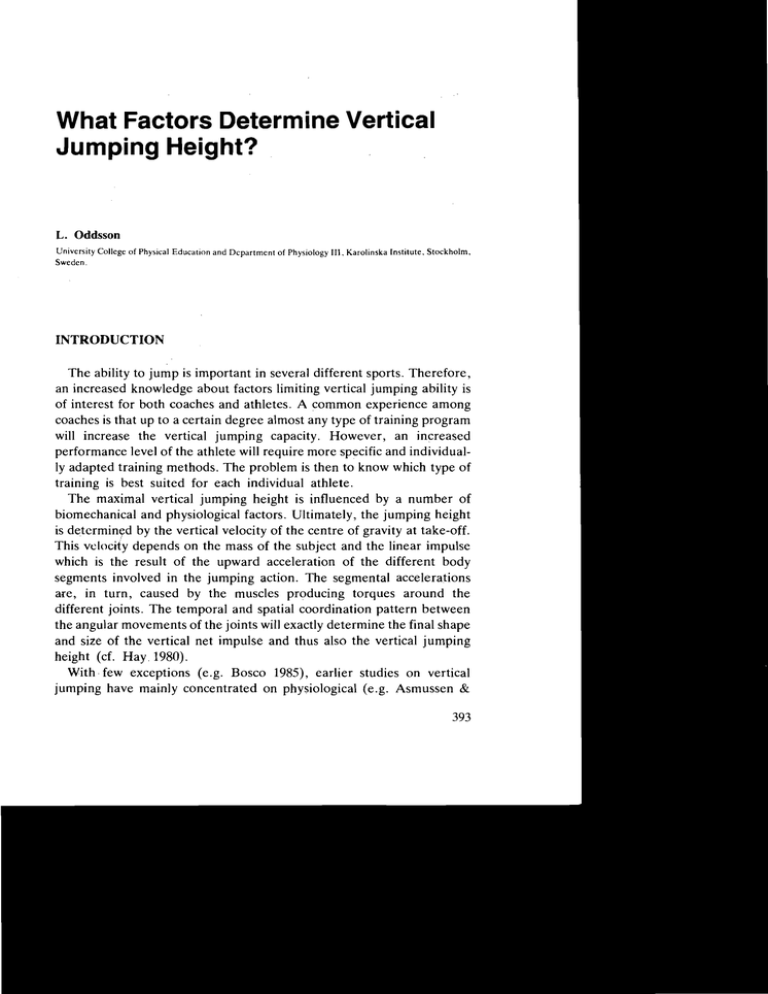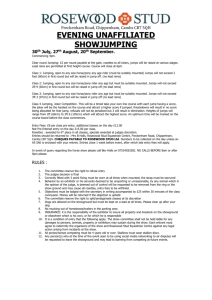this PDF file
advertisement

What Factors Determine Vertical Jumping Height? L. Oddsson University College of Physical Education and Department of Physiology Ill, Karolinska Institute, Stockholm. Sweden. INTRODUCTION The ability to jump is important in several different sports, Therefore, an increased knowledge about factors limiting vertical jumping ability is of interest for both coaches and athletes, A common experience among coaches is that up to a certain degree almost any type of training program will increase the vertical jumping capacity, However, an increased performance level of the athlete will require more specific and individual­ ly adapted training methods. The problem is then to know which type of training is best suited for each individual athlete. The maximal vertical jumping height is influenced by a number of biomechanical and physiological factors. Ultimately, the jumping height is detcrminyd by the vertical velocity of the centre of gravity at take-off. This velocity depends on the mass of the subject and the linear impulse which is the result of the upward acceleration of the different body segments involved in the jumping action. The segmental accelerations are, in turn, caused by the muscles producing torques around the different joints. The temporal and spatial coordination pattern between the angular movements of the joints will exactly determine the final shape and size of the vertical net impulse and thus also the vertical jumping height (cf. Hay 1980). With· few exceptions (e.g. Bosco 1985), earlier studies on vertical jumping have mainly concentrated on physiological (e.g. Asmussen & 393 Bonde-Pedersen 1974, Bosco & Komi 1980) or biomechanical (e.g. Luhtanen & Komi 1978, Hudson 1986) aspects of jumping not related to any practical test which could be useful for the individual athlete. The aim of this study was to investigate the relationship between parameters of the force-time curve of the vertical reaction force in different vertical jumps and the maximal jumping height attained during a counter movement jump. If certain force-time parameters can predict jumping height and also be influenced by specific training methods, it should be possible to test an athlete for each parameter and optimize the training process on an individual basis. METHODS A total of 106 subjects were studied (73 males and 33 females). The subjects were physical education students (n=96) and elite-athletes (volleyball players and weight lifters, n= 10) with a training background varying from approximately one training session a week to one session a day. Their mean (±ISD) height and weight were 1.79±0.1O m (1.58-2.00 m) and 74.3±11.9 kg (48.8-106.0 kg), respectively. Each subject performed three different forms of vertical jumps on a force plate (Kistler): 1) a maximal counter movement jump with the hands fixed at the hips (CMJ), 2) a maximal counter movement jump with a free arm swing (CMJ +), 3) repetitive bounce jumps (BJ) with the hands at the hips. Each of the counter movement jumps were performed three times. The bounce jumps were performed at a self-selected rate and the subjects were instructed to minimize the ground contact time. The vertical component of the ground reaction force was recorded on a Mingograf 803 (frequency response DC-1200 Hz). The subjects were instructed to take-off and land on the force plate with the same body position. This assured that the position of the centre of gravity in the body was the same in the two situations, thus allowing the height of rise of the centre of gravity to be calculated from the flight time of the jump. The height of rise of the centre of gravity was obtained from the formula, h = 1.226 x tr (Asmussen & Bonde-Pedersen 1974), where t r is the flight time as measured from the force-time records (cf. Fig. 2). The following jumps were selected and further analyzed according to Figure I: 394 MINGOGRAPH AMPLIFIER' Fig. 1 Schematic view of the experimental situation used in the study. The subjects performed vertical jumps on a force-plate (Kistler). The vertical ground reaction force was recorded on a Mingograf • 803. 395 1000 N F, I F2 CMJ sw tf F1 F2 sw CMJ+ tt.. FS BWJt­ BJ r:---T tdB ttB 0.58 Fig. 2 Examples of the vertical ground reaction force recorded during the different forms of vertical jumping and the force-time parameters used in the regression analysis. The traces show counter move­ ment jumps without arm swing (CMJ, top), with arm swing (CMJ+, middle) and repetitive bounce jumps (BJ, bottom), respectively. BW indicates the body weight of the subject. 396 1) The highest counter movement jump without arm swing (CMJ), 2) The highest counter movement jump with free arm swing (CMJ +), 3) The fastest bounce jump, i.e. the one with the shortest ground contact time (selected during «steady state» bouncing, cf. Fig. 2). Means and standard deviations (SO) were calculated for all variables. Differences between two variables were tested with the Student's Hest. Simple and step-wise multiple regression analysis and the corresponding correlation coefficients were calculated using standard statistical proce­ dures. RESULTS Vertical jumping heights calculated from the flight time (t f ) ranged from 0.13 m to 0.50 m (mean ±lSD, 0.29±0.07 m) for ~ounter movement jumps! without arm swing (CMJ) for all subjects. The corresponding range for jumps with arm swing (CMJ +) was 0.15-0.58 m (0.35±0.09 m). The difference in height between the two types of jumps was significantly greater than 0.03 m (p<0.05, mean 0.05±0.03 m). Only two subjects achieved a lower (0.01 m) maximal height in CMJ than CMJ +. The largest difference was 0.16 m. The height during bounce jumping (BJ) ranged from 0.07 m to 0.32 m (0.19±0.05 m). The self-selected frequency during bounce jumping in a «steady state» was 1.76±0.20 Hz (1.32-2.37 Hz). The difference in frequency between subjects was either due to differences in ground contact time or flight time or both. The vertical ground reaction force during a counter movement jump showed one or two peaks during the propulsive phase of the impulse. Most subjects, including the best jumpers, showed two force peaks during CMJ and CMJ + (90 and 92%, respectively). The duration of the propulsive phase (td, t d+, cf. Fig. 2) was similar for both forms of counter movement jumps, 0.37±0.08 s (ranges 0.21-0.60 s) and 0.37±0.06 s (0.20-0.57 s) for CMJ and CMJ+, respectively. Also the times between the two force peaks were similar, 0.14±0.06 s (0.00-0.26 s) and 0.16±0.06 s (0.00-0.32 s) for CMJ and CMJ +, respectively. zero time between peaks indicates that only one force peak appeared during the jump. The values of the peak forces developed during CMJ were 1021 ±275 N (346- 2134 N) and 904±289 N (426- 2045 N) for the first and the second peak, respectively. The corresponding values for CMJ + were 949±275 N (310-1939 N) and 1065±306 N (499-1842 N). 397 Several different combinations of force-time parameters were tested before ten were selected for inclusion in the multiple regression analysis. Four of the independent variables were temporal parameters (tp • t p +' tdB and t m , for explanation of abbreviations see Fig. 2) and three were peak force values (F2 , F2+ and F B). An indicator of the steepness of the last part of the force-time curve of CMJ and CMJ + was obtained by dividing the value of the second peak force with the time from the occurrence of the peak to take-off. These two variables (S and S+) were also entered into the analysis. A highly significant multiple regression coefficient was found between the selected dependent and independent variables (R=0.86, p<O.Ol). This indicated that more than 73% of the variation in jumping height of a counter movement jump could be explained by a variation in the selected force-time parameters (See Table 1 for the multiple regression equation). The single best predictor of the vertical jumping height was the second peak force during a counter movement jump with arm swing (F2 +, r=0.66, p<O.Ol, Fig. 3). See also Table 2 for additional correlation coefficients between the different force-time parameters. E h = 014 + 1.53.10- 4 f2. r=0.66 p<O.OI n = 106 050 ~ ...., 0.40 ~ ~ ~ ., 0' 030 ~ 0' ~ E 020 ....," 0.10 '..", l. I 500 ! I 700 900 ! I 100 Second peak force ! 1300 (CMJ+) ! 1500 ! 1700 I 1900 f 2 • (N) Fig. 3 The relationship between vertical jumping height during a counter movement jump without arm swing (CMJ) and the size of the second peak force recorded during a counter movement jump with arm swing (CMJ +). The equation for the simple linear regression line is given together with the correlation coefficient (r) and the level of significance (p). 398 TABLE 1 Multiple regression coefficients (A 1 - A 9 , see formula below), constant (B), multiple correlation coefficient (R) and fraction of explained variance (R Z) calculated between jumping height during counter movement jump without arm swing (CMJ) (independent variable, h) and nine selected force-time parameters (dependent variables). The multiple regression equation is given in the form: h=A 1 'F2+ + Az,tp ++A3·tdB+A4·tm+A5·S+ A 6 ·S+ +A 7 ·tp + As'F B+ A 9 ·Fz+ B The dependent variables are arranged in the same order as they were entered into the step-wise multiple regression analysis, F2+ 1.78.10- 4 tp 0.24 tp + 0.37 tdB -0.61 tm 0.29 Fz Fa -1.53.10- 5 3.82.10- 5 B 0.04 S S+ 6.00,10- 6 -5.40-10- 6 RZ 0.73 R 0.86 TABLE 2 Simple linear correlation coefficients (r) between different force-time parameters and jumping height during CMJ (h). For definition of abbreviations see Figure 2. Significant correlation coefficients are indicated with asterisks (* - p < 0.05, ** - P < 0.01) h F, F2 + tp tp + S s+ FB t dB t rn h F2 F:!+ tp tp + S s+ FB t dB 0.45" 0.66" 0.16 O. I7 0.57*' O.5S" 0.63" -0.33" 0.44 " 0.72" -0.56" -0.27' 0.60" 0.5S" 0.53" -0.12 0.15 -0.14 -0.2S' 0.62" O.SO" 0.69" -0.14 0.26" 0.52" -0.12 -0.05 <-0.01 0.09 0.10 -0.20' -0.05 -0.01 0.04 0.13 0.65" 0.52" -0.22' 0.25" 0.59" -0.21' 0.25" -0.51" 0.39" -0.04. 399 DISCUSSION The results of this study showed that the vertical jumping height during a counter movement jump could be predicted quite accurately from selected parameters of the force-time curves of different types of vertical jumps. This was indicated by the high correlation coefficient obtained in the multiple regression analysis (R=0.86). Other studies have used similar methods to study the relationship between vertical jumping height and the torque produced arouhd different joints during the jump (Hay et al. 1980) and the pattern of coordination between different segments (Hudson 1986). The results of these studies contributed significantly to our understanding of the relationships between basic biomechanical principles and human movement. However, they were based on a kinematic analysis of the jumping performance which is a very time­ consuming procedure and thus not applicable for a coach or an athlete. An important aim of this study was to relate the results to a practical test that could be used by coaches and athletes in the training process for vertical jumping. To measure certain parameters from the force-time records obtained during a series of different jumps on a force-plate is rather simple and can quickly give valuable suggestions for future training. If the force-time parameters could be selectively influenced by different types of training programs it would be possible to test an athlete for these parameters and then give him/her a highly specific and individual training program based on his/hers actual weaknesses. This increase of specificity in the training might provide the extra stimulus needed to break through earlier limits of performance. However, this requires an increased knowledge about how different training regimes influence the force-time curves in various test situations. Preliminary results from a training study (Oddsson unpubl. observations) have indicated that the ground· contact time of a bounce jump can be specifically influenced by a training model in which the extensor muscles are exposed to high eccentric loads. The aim of future studies will be to test and develop training methods which specifically influence critical parameters of the force-time curve and thus also the jumping height. 400 REFERENCES Asmussen, E. and F. Bonde-Pedersen, Storage of elastic energy in skeletal muscle in man. Acta Physiol Scand, 91.385-392, 1974. Bosco, C. and P. V. Komi, Influence of countermovement amplitude in potentiation of muscular performance. In: A. Morecki et al. (ed.), Biomecha­ nics VII-A, pp. 129-135. University Park Press, Baltimore 1980. Bosco, c., Stretch-shortening cycle in skeletal muscle function and physiological considerations on explosive power in man. pp. 7-113. Atleticastudi 1. Centra Studi & Richerche Fidal 1985. Hay, J. G., C. L. Vaughan and G. G. Woodworth, Technique and performance: Identifying the limiting factors. In: A. Morecki et al. (ed.), Biomechanics VII-B, pp. 511-520. University Park Press, Baltimore 1980. Hudson, J. L., Coordination of segments in the vertical jump. Med Sci Sports Exerc, 18. 242-251, 1986. Luhtanen, P. and P. V. Komi, Segmental contribution to forces in vertical jump. Eur J Appl Phy~iol, 38. 181-188, 1978. ACKNOWLEDGEMENT This study was supported by grants from the University College of Physical Education in Stockholm and the Swedish Sports Research Council. The valuable comments on the manuscript by Or. A. Thorsten­ sson are gratefully acknowledged. 401


